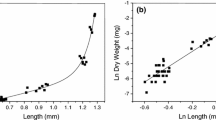Abstract
The acute toxicity of heavy metal salts onDaphnia similis Claus is studied in terms of LC50. Copper is found to be the most toxic and zinc the least. Toxicity of the heavy metals is studied by observing changes in the longevity, body length, fecundity and moulting frequency of the animal. The decreasing order of toxicity of heavy metals on the longevity, body length and fecundity is indicated by Zn>Pb>Cu>Hg, Cu>Zn>Hg>Pb and Pb>Cu>Zn>Hg respectively. The average number of instars increased with the increase of the concentration of metals in the medium. The order of accumulation pattern is Zn>Pb>Cu for 24 h and Zn>Cu>Pb for 48 h. On doubling the concentration of metal to whichDaphnia similis is exposed and fed to the fishSaratherodon mossambicus, the biomagnification increases for copper and zinc while it decreases for lead.
Similar content being viewed by others
References
Bertram P E 1980Population response of Daphnia to long-term exposure to cadmium, Ph D thesis, University of Wisconsin, Milwaukee, USA
Chen J C, Jung S B and Hong W C 1980 Study on the sublethal effects of heavy metals on some freshwater aquatic animals;China Fish. Mon. 325 5–18
Dave G 1984 Effects of waterborne iron on growth, reproduction, survival and haemoglobin inD. magna;Comb. Biochem. Physiol. 78 433–438
Dethlefsen V 1978 Uptake, retention and loss of cadmium by brown shrimp (Gangon crangon);Meeresforsch 26 237–352
Eaton F G 1973 Recent developments on the use of laboratory bioassays to determine ‘safe’ levels of toxicants for fish; inBioassay techniques and environmental chemistry (ed.) G E Glass (Ann Arbor: Sci. Publ.) pp 107–115
Hall D J 1964 An experimental approach to the dynamics of a natural populations ofDaphnia galeata mendota;Ecology 45 94–112
Ingersoll C G and Winner R W 1982 Effect onDaphnia pulex (Degeer) of daily pulse exposure of copper or cadmium;Environ. Toxicol. Chem. 1 321–327
Leeuwangh P 1977 Toxicity tests with daphnids: its application in the management of water quality;Hydrobiologia 59 145–148
Ribeyre F 1981 Contamination of an experimental trophic chain by methyl mercury-importance of the primary production consumption system;Environ. Pollut. 24 193–206
Venkataraman K 1981 Field and laboratory studies onDaphnia carinata King (Cladocera: Daphnidae) from a seasonal tropical pond;Hydrobiologia 78 221–225
Vighi M 1981 Lead uptake and release in an experimental trophic chain;Ecotoxi. Environ. Safety 5 177–193
Winner R W 1981 A comparison of body length, brood size and longevity as indices of chronic copper and zinc stresses inDaphnia magna;Environ. Pollut. 26 33–37
Winner R W 1986 Bioaccumulation and toxicity of copper as affected by interactions between humic acid and water hardness;Water Res. 19 449–455
Winner R W and Farrell M P 1976 Acute and chronic toxicity of copper to four species ofDaphnia;J. Fish. Res. Board Can. 33 1685–1691
Author information
Authors and Affiliations
Rights and permissions
About this article
Cite this article
Soundrapandian, S., Venkataraman, K. Effect of heavy metal salts on the life history ofDaphnia similis Claus (Crustacea: Cladocera). Proc Ani Sci 99, 411–418 (1990). https://doi.org/10.1007/BF03191875
Received:
Revised:
Issue Date:
DOI: https://doi.org/10.1007/BF03191875



